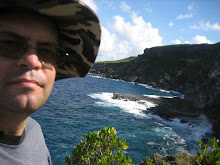Me, the co-pilot. Luckily I didn't have to do anything.



Other than the two pickups and a few concrete huts, the culture of Woleai was just as it always had been. The women still wear only a lava lava and the men a thu. Also, women were not allowed to walk past a sitting man who is a close relative of theirs. Everyone on island was related but they had some way of remembering who was closely related to who. If a woman needed to pass a sitting man she would have to walk out of her way to make a wide circle around the man. This cultural trait was sure confusing with the introduction of the pickup. The man was sitting in the truck but driving past the walking women. When this happened, I notice the women related to the chief frantically ran into the jungle and sat down, and that wasn't only because the truck had no brakes.


Every morning, long before sunrise, the men set sail to go fishing. They had long sticks with the same length fishing line tied to the end. As the canoe sailed they lowered the stick to let their line drag behind. When the fish bites they simply pointed the stick straight up and the fish lands in the canoe.
No one on island was allowed to eat anything until the canoes returned. Sometimes this was late in the day and I was starving. One day they were particularly late returning. The whole island was waiting at the beach for them. Finally one person pointed to sea and said, "Here they come". I strained my eyes as much as I could but it was still another 10 minutes before I could see them. The sailors gave some signal that the catch was good and everyone on the beach was celebrating.

I was starving but seeing all those flies on the fish started to make me loose my appetite. Finally the all clear sign was given and all were allowed to eat. Everyone ran to the pile of fish, picked up one fish and bit into it. I decided to waited until dinner before I ate that day.
Exploring Woleai was exciting. The island was fortified by the Japanese during WWII but the Americans never attacked. Instead, the American Navy formed a blockade around the circle of Woleai atolls and starved the Japanese to death. The local population were chased off to the remote Woleai atolls by the Japanese long before and had no problem surviving the blockade.
The Japanese fortifications were intact and undisturbed since WWII. Bottles were still on shelves in bunkers right where the Japanese soldier put it before he died. Rounds were still in anti-aircraft guns waiting for the American attack that never came. Small cannons on wheels were just inside bunker openings so they could be rolled out and used in a hurry. Bombs were near the runway waiting to be loaded on Japanese airplanes that never returned. In one of the villages there is a modern monument built by the Japanese in memory of the "tens of thousands" of Japanese soldiers that died on the Woleai atoll.
Japanese airplane.

Portable cannon in a bunker.

Loaded Japanese anti-aircraft gun.

The date on the chalk board is March 25, 1996.

After everything and everyone was weighed, Peter personally loaded each bag into the plane's storage area. "We are overloaded," he said to me. He took everything back off the plane. He then asked for two volunteers to wait another two weeks before going to Yap. With only 10 passengers I was surprised that he quickly found two volunteers to stay behind. It could have been as simple as: the two heaviest must volunteer.
Once all the boxes and bags and my duffle bag and the live chicken was loaded, it was time to load the passengers. I was first. He put me in the co-pilot's seat. Even though I was scared to sit there, afraid that I may accidentally touch something, I still thought that was a good choice on Peter's part. Then one-by-one the heavy men were put in alternating sides of the plane. After all the seats were full it was time for Peter to bring the women on board, one-by-one. They had to sit on the floor. The first couple of women went fine but there was a big commotion when Peter asked the third woman to sit. She refused. It turned out that one of the sitting men near the spot where she was asked to sit was a close relative.
"Everyone back off the plane," Said Peter. He turned to me and laughed, "Now I need to find out who is related to who."
Woleai airport.

Japanese WWII runway still used today.

Woleai lagoon.

In front of my concrete hut next to the runway.
I have no idea what the Japanese used that big wheel for.
I have no idea what the Japanese used that big wheel for.



Big Japanese canon.

Looking at Polaroid photos of themselves that I gave them.



No comments:
Post a Comment